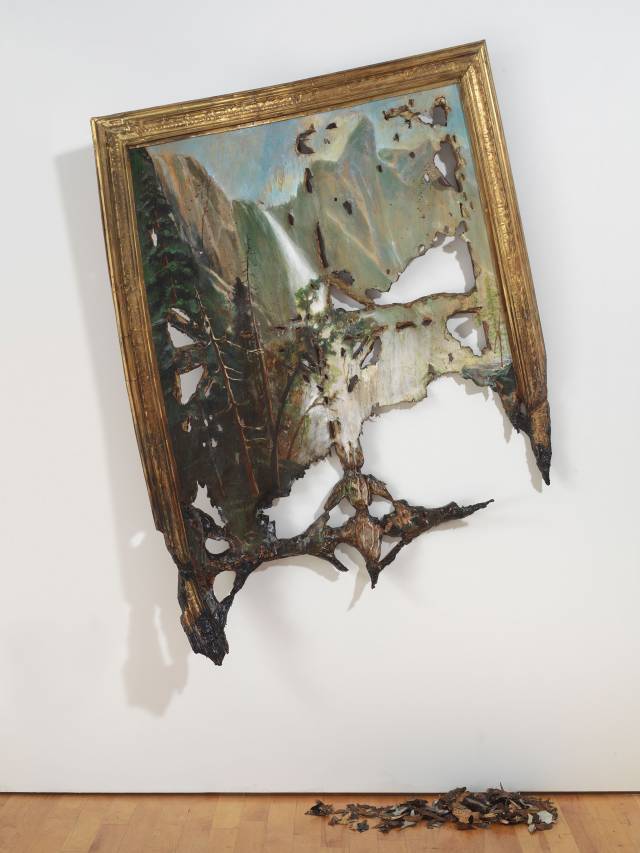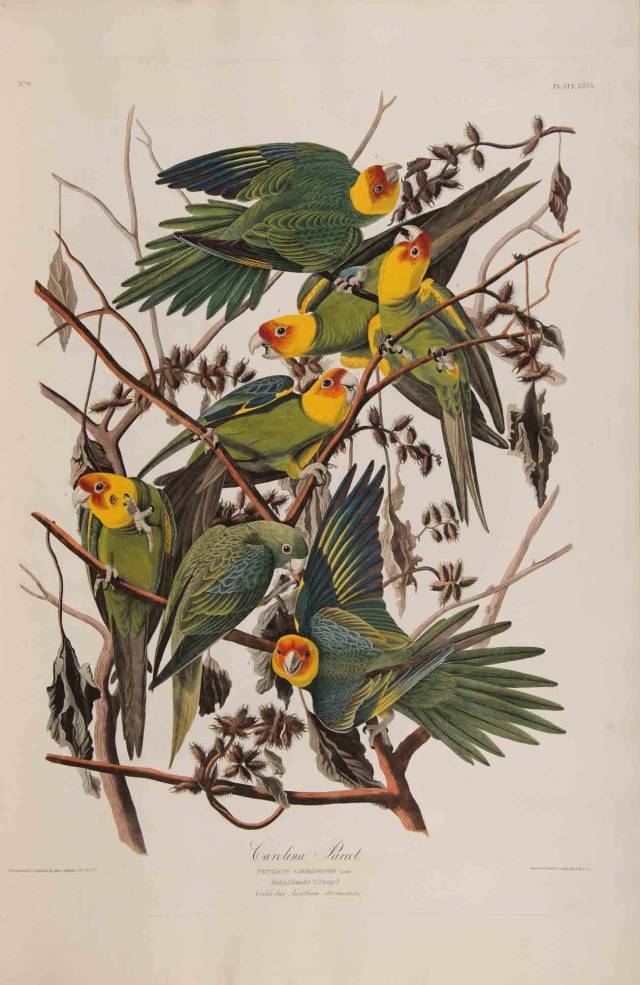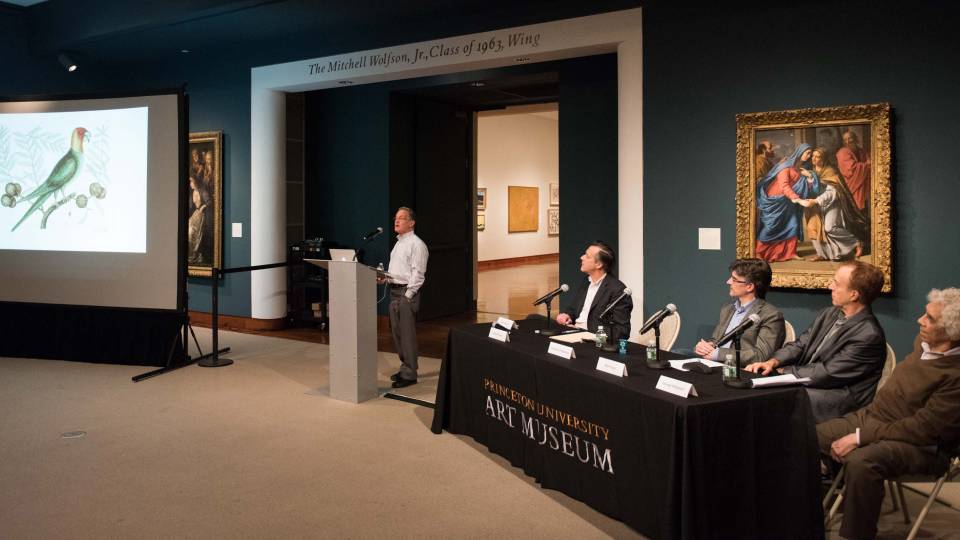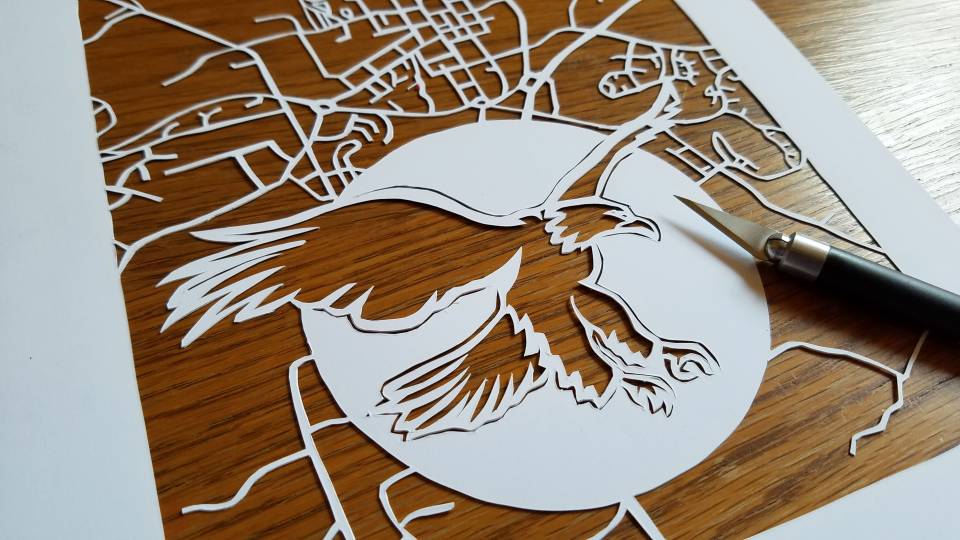The exhibition "Nature's Nation: American Art and Environment," is on view Oct. 13, 2018-Jan. 6, 2019, at the Princeton University Art Museum. Pictured: Albert Bierstadt, American, 1830–1902, "Mount Adams, Washington," 1875. Oil on canvas. Princeton University Art Museum. Gift of Mrs. Jacob N. Beam.
"Nature’s Nation: American Art and Environment," on view Oct. 13, 2018-Jan. 6, 2019, at the Princeton University Art Museum, explores for the first time how American artists of different traditions and backgrounds have both reflected and shaped environmental understanding while contributing to the development of a modern ecological consciousness.
The exhibition features more than 120 paintings, sculptures, prints, drawings, photographs, videos and works of decorative art, from the colonial period to the present. Read about the research behind the making of the exhibition.

Valerie Hegarty, American, born 1967, "Fallen Bierstadt," 2007. Foamcore, paint, paper, glue, gel medium, canvas, wire, wood. Brooklyn Museum, gift of Campari, USA 2008.9a-b. © Valerie Hegarty. Courtesy of the artist and Guild & Greyshkul, NY.
The works reflect a wide range of genres and historical contexts — from colonial furniture to the art of Jeffersonian natural science, from Hudson River landscape painting to Native American basketry, from Dust Bowl regionalism to modernist abstraction and postwar environmental activism — highlighting the evolving ecological implications of subjects and contexts of creation as well as artistic materials and techniques. The result is a major reinterpretation of American art that examines both iconic masterpieces and rarely seen objects through a lens uniting art historical interpretation with environmental history, scientific analysis and the dynamic field of ecocriticism.
“'Nature’s Nation' advances a new approach to understanding and interpreting American art of the past three centuries, opening up rich avenues of engagement with both celebrated and less familiar works of art,” said James Steward, the Nancy A. Nasher–David J. Haemisegger, Class of 1976, director. “At a time when the question of our relationship with the natural world is so much on our minds, 'Nature’s Nation' positions the museum as a crucial site for close looking, conversation and exchange on questions that matter both to our identities as Americans and to our future."
The exhibition is the culmination of years of innovative research by co-curators Karl Kusserow, the John Wilmerding Curator of American Art at the Princeton University Art Museum, and Alan C. Braddock, the Ralph H. Wark Associate Professor of Art History and American Studies at William & Mary. To help rethink American art history in environmental terms, they have selected works by more than 100 artists, including John James Audubon, George Bellows, Albert Bierstadt, Frederic Edwin Church, Thomas Cole, Thomas Eakins, Theaster Gates, Winslow Homer, Louisa Keyser, Dorothea Lange, Ana Mendieta, Thomas Moran, Isamu Noguchi, Georgia O’Keeffe, Maya Lin, Frederick Law Olmsted, Charles Willson Peale, Jackson Pollock, Robert Rauschenberg, Alexis Rockman, Robert Smithson, Carleton Watkins and Andrew Wyeth.
"Nature’s Nation" begins with an introductory gallery, where iconic paintings by Albert Bierstadt ("Bridal Veil Falls, Yosemite," ca. 1871-73) and Thomas Moran ("Lower Falls, Yellowstone Park," 1893) are displayed alongside works by Valerie Hegarty ("Fallen Bierstadt" 2007) and Jaune Quick-to-See Smith ("Browning of America," 2000) that revise and complicate earlier perceptions of the pristine American environment. The 15 diverse works in the introduction set the stage for the following sections, which together reveal our evolving sense of what nature means and how we as humans relate to it.
The first, Colonization and Empire, focuses on images of the young Republic’s ideas about natural order, as seen in Charles Willson Peale’s renowned "The Artist in His Museum" (1822), before exploring picturesque and sublime representations of the land in paintings such as Thomas Cole’s "Home in the Woods" (1847), and Americans’ plans for nature’s transformation, as in Frederick Law Olmsted’s enormous Central Park “Greensward Plan” (1858).
A second section, Industrialization and Conservation, explores work that addresses the tensions between progress and preservation, including complex representations of consumption and its effects by Winslow Homer ("Prisoners from the Front," 1866), Thomas Anshutz ("The Ironworker’s Noontime," 1880) and a Standing Rock Sioux artist (a stretched buffalo robe of 1882).
Finally, Ecology and Environmentalism considers art of the 20th and 21st centuries that reimagines ecology on a global scale through expansive techniques and media. Among the works featured are Georgia O’Keeffe’s iconic "The Lawrence Tree" (1929) and Robert Rauschenberg’s lithographic collage announcing the first "Earth Day" (1970).

John James Audubon, American, 1785–1851, "Carolina Parakeet," in "The Birds of America," plate 26, 1827–38. Princeton University Library, Department of Rare Books and Special Collections, Firestone Library, Princeton University.
Lenders include 70 eminent national collections, both private and public, as well as works drawn from Princeton’s extensive holdings.
After its debut at Princeton, the exhibition travels to the Peabody Essex Museum in Salem, Massachusetts (Feb. 2-May 5, 2019), and Crystal Bridges Museum of American Art in Bentonville, Arkansas (May 25–Sept. 9, 2019).
A major 448-page catalogue, published by the Princeton University Art Museum and distributed by Yale University Press, accompanies the exhibition.
Related programming
Opening celebration: "Nature’s Nation: American Art and Environment"
5 p.m. Sat., Oct. 13
Lecture by exhibition curators, “Exhibiting Nature’s Nation: Ecology and Environment in American Art,” 10 McCosh Hall, followed by reception in the museum
Film screening: "The Man Who Fell to Earth" (1976)
7:30 p.m., Wednesday, Oct. 17
Introduction by Princeton University Art Museum Associate Director for Education Caroline Harris; part of a fall film series focusing on films that present fresh ideas about the environment for their time. Museum members receive Princeton Garden Theatre member admission prices.
Princeton Garden Theatre, 160 Nassau St.
Lecture: Environmentalist and author Bill McKibben
5:30 p.m. Thursday, Oct. 25
Princeton University, Richardson Auditorium, followed by a reception in the museum
Film screening and discussion: "Through the Repellent Fence," with members of the transdisciplinary indigenous arts collective, Postcommodity
2 p.m. Friday, Nov. 9
Princeton Garden Theatre, 160 Nassau St.
Author and environmentalist Naomi Klein, in conversation with activist/scholar Ashley Dawson (CUNY)
5:30 p.m. Thursday, Nov. 15
Princeton University, McCosh 50
Gallery talk: Indigenous Belongings and Belonging with India Young
2 p.m. Friday, Nov. 16
Princeton University Art Museum, "Nature’s Nation" galleries
Artist Alexis Rockman, in conversation with exhibition co-curator Alan Braddock
5:30 p.m. Thursday, Nov. 29
Princeton University, location TBD
Panel: Princeton Environmental Institute faculty response to "Nature’s Nation," moderated by exhibition co-curator Karl Kusserow
2 p.m. Friday, Nov. 30
Princeton University Art Museum
Symposium: Picture Ecology: Art and Ecocriticism in Planetary Perspective, international symposium organized by exhibition co-curator Karl Kusserow
Friday, Dec. 7, and Saturday, Dec. 8
Princeton University, McCosh 10
Princeton University Art Museum is located at the heart of the Princeton campus, a short walk from the shops and restaurants of Nassau Street. Admission is free. Museum hours are Tuesday, Wednesday, Friday and Saturday, 10 a.m.-5 p.m.; Thursday, 10 a.m.-9 p.m.; and Sunday, noon-5 p.m. The museum is closed Mondays and major holidays.






